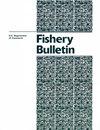Reproductive characteristics for the blue shark (Prionace glauca) in the North Atlantic Ocean
IF 0.8
4区 农林科学
Q3 FISHERIES
引用次数: 1
Abstract
4 University of Rhode Island 120 Flagg Road Kingston, Rhode Island 02881 Abstract—The blue shark (Prionace glauca) in the North Atlantic Ocean is caught in large numbers in commercial fisheries and faces the possibility of overfishing. Reproductive parameters, such as size and age at maturity, are important descriptors of life history characteristics used for understanding and managing marine organisms but have not been evaluated for the western North Atlantic Ocean since 1979. To address this gap in knowledge, we used samples from 369 female and 488 male blue sharks collected during 1971–2016 and examined whether maturity parameters have changed over time. We compared sexspecific fork length (FL) (L50) and weight (W50) at median maturity between 2 time periods (1971–1977 and 2003–2016). No evidence of change in either L50 or W50 was observed for females. Males had a statistically significant increase in both parameters; however, this increase was likely the result of differences in sample size range between the time periods. Thus, all data from 1971 through 2016 were combined to obtain new estimates of age and size at 50% maturity for both sexes. The L50 and W50 are 192.5 cm FL and 49.5 kg for male blue sharks and 190.9 cm FL and 50.1 kg for female blue sharks. These updated L50 and W50 increase reliability of data inputs for fisheries management.北大西洋蓝鲨(Prionace glauca)的生殖特征
摘要北大西洋的蓝鲨(Prionace glauca)在商业渔业中被大量捕获,面临过度捕捞的可能性。生殖参数,如大小和成熟年龄,是用于了解和管理海洋生物的重要生活史特征描述符,但自1979年以来尚未对北大西洋西部进行评估。为了解决这一知识空白,我们使用了1971-2016年期间收集的369只雌性和488只雄性蓝鲨的样本,并研究了成熟度参数是否随着时间的推移而变化。我们比较了两个时期(1971-1977年和2003-2016年)中位成熟度的性别特异性叉长(FL) (L50)和重量(W50)。在女性中没有观察到L50和W50变化的证据。男性在这两个参数上都有统计学上的显著增加;然而,这一增长可能是由于不同时期的样本量范围不同造成的。因此,将1971年至2016年的所有数据结合起来,获得了两性在50%成熟时的年龄和体型的新估计。雄性蓝鲨的L50和W50分别为高度192.5厘米和49.5公斤,雌性蓝鲨为高度190.9厘米和50.1公斤。更新后的L50和W50提高了渔业管理数据输入的可靠性。
本文章由计算机程序翻译,如有差异,请以英文原文为准。
求助全文
约1分钟内获得全文
求助全文
来源期刊

Fishery Bulletin
农林科学-渔业
CiteScore
1.70
自引率
12.50%
发文量
76
审稿时长
>24 weeks
期刊介绍:
The quarterly Fishery Bulletin is one of the oldest and most respected fisheries journals in the world. It has been an official publication of the U.S. Government since 1881, under various titles, and is the U.S. counterpart to other highly regarded governmental fisheries science publications. It publishes original research and interpretative articles in all scientific fields that bear on marine fisheries and marine mammal science.
 求助内容:
求助内容: 应助结果提醒方式:
应助结果提醒方式:


